Yoga for Bloating | Backed Up? Try These 10 Yoga Poses To Stop and Prevent Bloating
Bloating is a feeling of tightness and pressure in the belly, ranging from merely uncomfortable to downright painful. Bloating and constipation are linked, but constipation is more the result of bloating than a standalone condition. You want to avoid...

Bloating is a feeling of tightness and pressure in the belly, ranging from merely uncomfortable to downright painful.
What causes bloating? It’s not pretty. When your colon backs up with poop, the recently-digested stuff you ate stays longer in the intestines as it waits to descend. Your body expands to contain the extra stuff, leading to bloating.
Bloating and constipation are linked, but constipation is more the result of bloating than a standalone condition. You want to avoid both, of course, and yoga combined with nutrition and lifestyle changes can prevent this uncomfortable, embarrassing situation from arising.
Digestion and Bloating
We take for granted our digestive systems, assuming that what we eat and drink will pass smoothly through our bodies, eventually ending in the commode via a satisfying bowel movement at least once a day.
When that doesn’t happen, resulting in bloating and constipation, we assume it must be due to something we ate. Or maybe a virus, genes, something hereditary, perhaps. In reality, we usually have ourselves to blame.
That’s because bloating, like much of what ails us, can be solved by performing more movement, drinking more water, and consuming less processed, more fiber-rich food. Do all three things consistently, and you’ll rarely deal with bloating. On the other hand, if you’re not drinking enough water, eating junk, and not moving, you’ll soon feel bloated.
Yoga for Digestion | Quick 20 Minute Morning Yoga Routine

Yoga for Gas and Bloating
Think of how most of us spend our days. We sit at desks and behind steering wheels. We’re hunched over screens and wedged into airline seats. If you wanted to design a lifestyle to prevent food and nutrients from smoothly passing through the body, that’s what you’d create. Not only are you not burning calories, but you’re also likely eating poorly and not putting yourself in a position, literally, for waste to flow down and out of the body.
In the typical sedentary American lifestyle, any movement will help with bloating. But yoga is especially effective since it lengthens and strengthens muscles, promotes efficient breathing, and makes you more mindful of your body’s systems. You might never stop to think of how waste is flowing out of your body while performing yoga, aside from dealing with a potential fart scenario in yoga class, but keeping your body stretched and limber helps promote digestion and discourages bloating.
If you’re bloated, performing a few yoga moves like the ones below will provide immediate relief. But think of bloating prevention as another benefit of a regular yoga regimen.
And if you have gas, read one of our most popular blogs on How to Make Yourself Fart!
Bloating vs. Fat
Feeling bloated is not the same as feeling fat. Nor is bloating that post-Thanksgiving food coma the same as being bloated. That’s feeling stuffed.
There is a relationship between bloating and fat, however. Unlike women, who distribute weight fairly regularly all over their bodies, guys tend to put it all on their bellies, which diminishes core strength and the ability to move waste through the body. That makes us more prone to heart disease and, yes, bloating. Recent weight gain wreaks havoc with the normal digestive process. What you might have viewed as an everyday meal for years makes you feel bloated after a recent 10-pound weight gain.
How to Stop Bloating
Television commercials for decades have portrayed bloating and acid indigestion as a random act of nature. Not your fault at all. So, pop an antacid, and this inconvenience will, ahem, pass in no time.
Or at least until you feel bloated again due to poor lifestyle choices. In reality, bloating results from a lack of movement, not drinking enough water, and consuming a diet high in processed foods rather than one rich in fiber.
The good news is that when it comes to lifestyle changes, those are three of the easiest to make.
MOVE MORE: It stands to reason that waste will sit in your gut and bowels if you’re sitting and inactive. The more you move, the more you encourage the stuff you consume to move through your body, providing it with the energy it needs and ultimately out the back door.
That’s why the first thing a bloated or constipated person does is walk. It’s why doctors get patients on their feet and walking as soon as possible after surgery; anesthesia can cause bloating and constipation, even though patients likely had nothing to eat for 8 to 12 hours before surgery.
So, if movement is the prescription for short-term bloating, it figures it’s also the preventative measure. An active lifestyle of any sort can promote this, but yoga is especially effective.
DRINK MORE WATER: For all of the hoopla surrounding nutrient-infused waters and teas, we’ve never created something better than water, which boosts performance, prevents all manner of ills, and is necessary for life. For nutrients to pass smoothly through the body, it takes a lot of water, and you’re likely not drinking enough. Not only that, you might be consuming alcohol and caffeine, which could contribute to bloating.
Bottom line: drink at least one ounce of water per pound of body weight daily.
EAT MORE FIBER: Nothing prevents bloating more effectively than fiber, which improves gastrointestinal health and function and helps prevent colon cancer. It regulates blood sugar levels, keeps you full, and promotes long-term cardiovascular health by reducing cholesterol. Fiber is found in whole grains, oatmeal, fruits, and green leafy vegetables. Fiber causes you to drink more water, so you’ll accomplish two anti-bloating goals simultaneously.
You can take fiber supplements, too, but if you’re eating a proper diet low in processed foods, you should get plenty of fiber.
Ten Yoga Poses for Gas and Bloating
Cat-Cow Stretch
This slow movement from an arched to rounded spine is one of the best exercises you can do for your back, whether you are an athlete warming up or a non-athlete recovering from a back injury. Use this exercise to mobilize your spine, release kinks or stiffness in your back, and prepare for exercise.
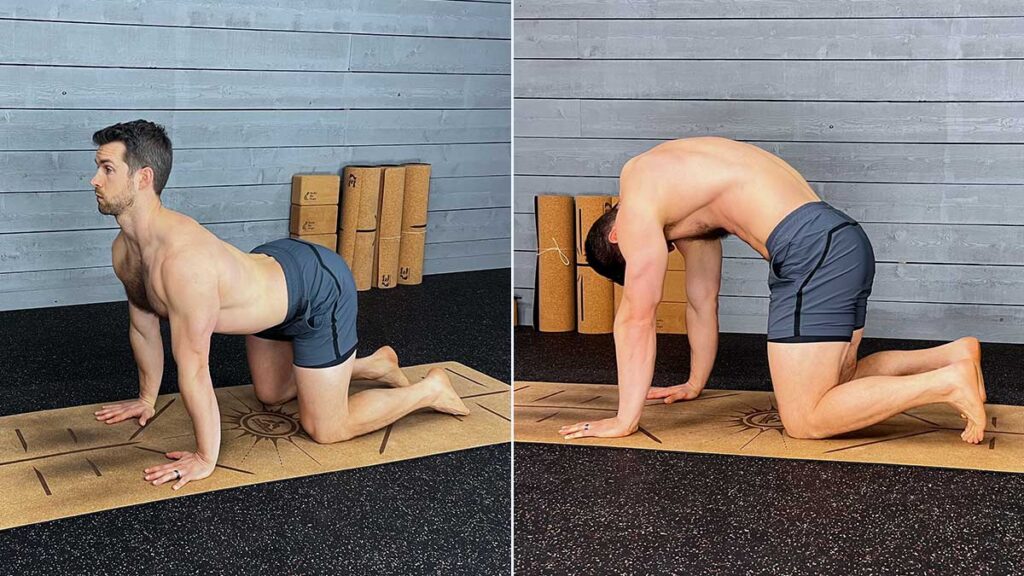 Cat Cow Stretch
Cat Cow StretchHappy Baby Pose
This is a great stretch for your groin to help relieve lower-back pain. Use Happy baby before a yoga workout to help warm up, or after a workout session to release muscle tension and speed up recovery. This posture is also perfect for when you want to move but don’t feel like exercising.
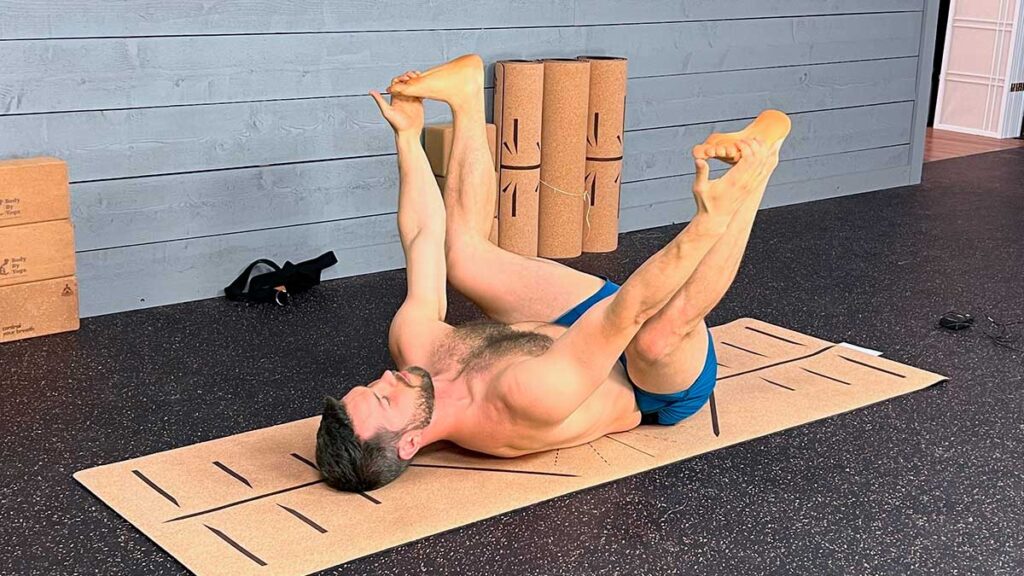 Happy Baby Pose
Happy Baby PoseChild’s Pose
This is an all-purpose pose to relax your body and release tension in your spine, back, and hips. It’s a great cool down to return your breathing to normal, or a warm up to activate the core, upper back, and shoulders. Child’s pose also helps relieve stiffness in the spine after sitting for an extended period of time
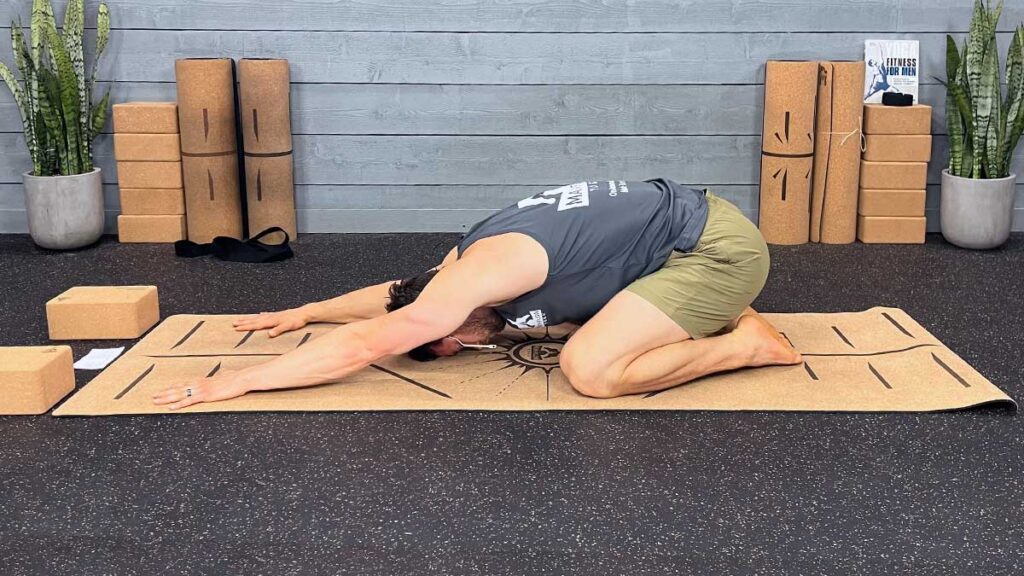 Child’s Pose
Child’s PoseDownward Dog Pose
This quintessential yoga posture stretches the calves and hamstrings, properly aligns the spine, improves shoulder mobility, and strengthens your hips, back, and core. It’s great for athletes to improve lower-body strength and flexibility, and for weight lifters who need to stretch tight muscles and recover quickly.
 Downward Dog Pose
Downward Dog PoseLow Lunge
This posture is an essential pillar of a strong lower body. It strengthens your hips, glutes, thighs, and core, improves your hip mobility, and prevents injury in your knees, back, and hips. Low lunge is very important for people who sit often, as well as athletes interested in building power and preventing injury.
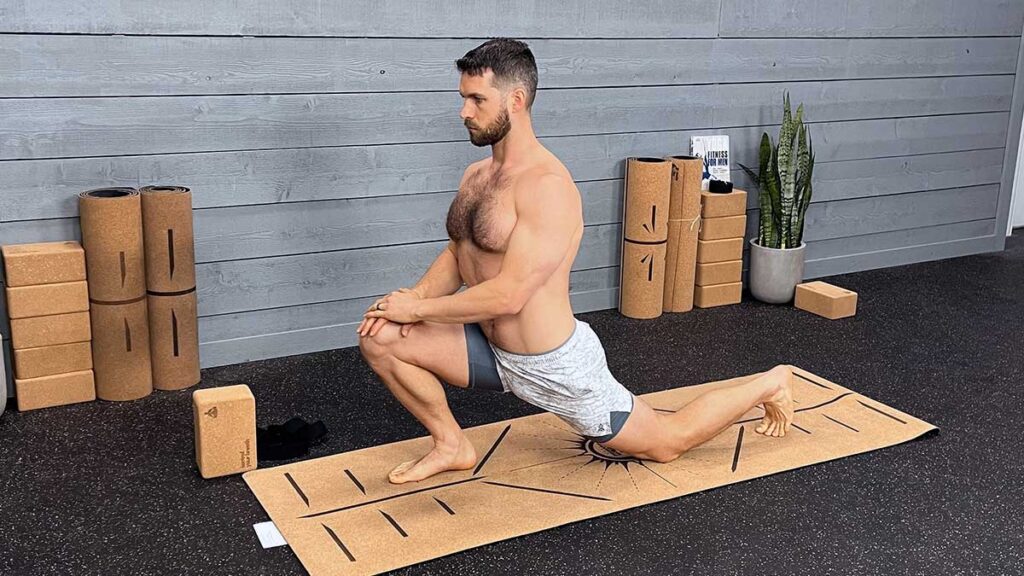 Low Lunge
Low LungeForward Fold
This posture actively stretches your hamstrings to release tension in your spine and back. Focus on engaging the correct muscles to stretch the hamstrings, and don’t worry about whether you can touch your hands to the floor. This posture is great after a workout or long walk.
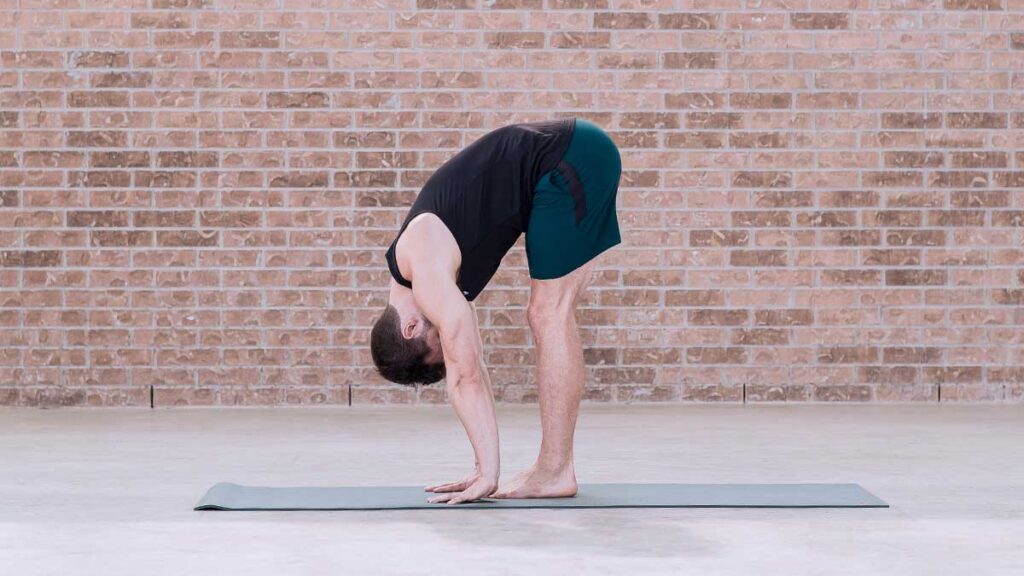 Forward Fold
Forward FoldChair Pose
This basic yoga squat is perfect for runners, people who sit often, and anyone who wants to have better workouts. Chair develops muscle activation in your glutes, improving your squats, lunges, and sprints. It also prevents lower-back pain and strengthens your knees.
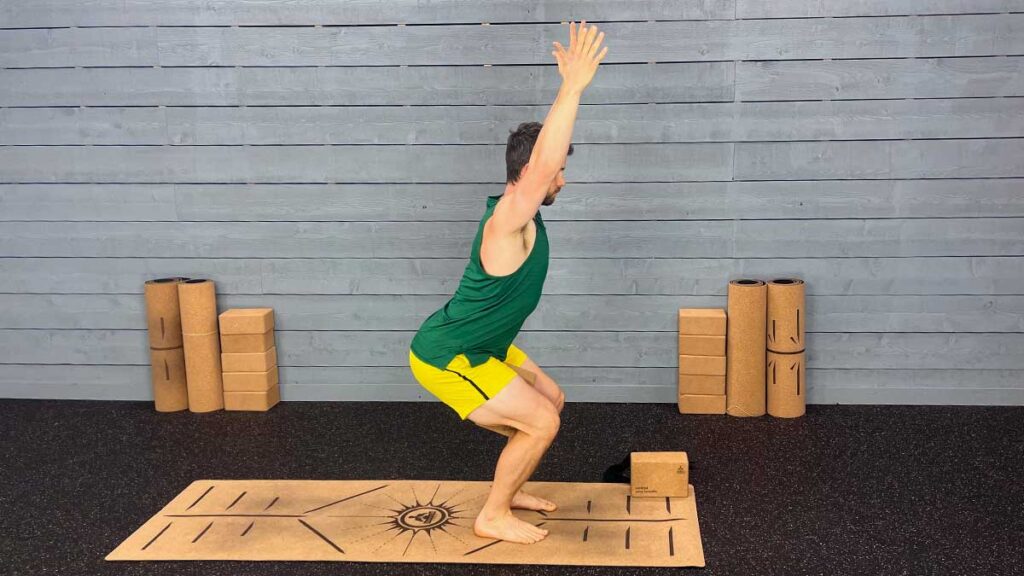 Chair Pose
Chair PoseBridge Pose
Bridge safely arches your back while strengthening your hips and core. This posture is essential for building stability in the spine and hips, especially for backbends. Do this exercise after a long day of sitting to balance your posture, or use this as a warm up to prepare the spine for a workout.
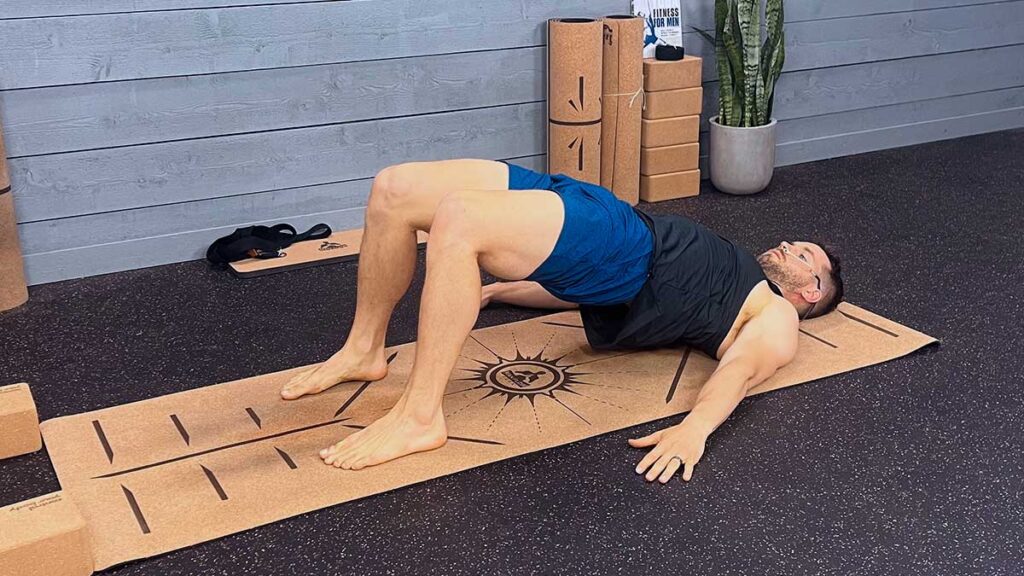 Bridge Pose
Bridge PoseSpinal Twist
Twisting is an essential movement for maintaining a strong and mobile spine. This posture is one of the most basic twists you can do. Use at the end of a workout to speed up recovery, or the beginning of a workout to help open your spine for improved performance and reduced risk of injury.
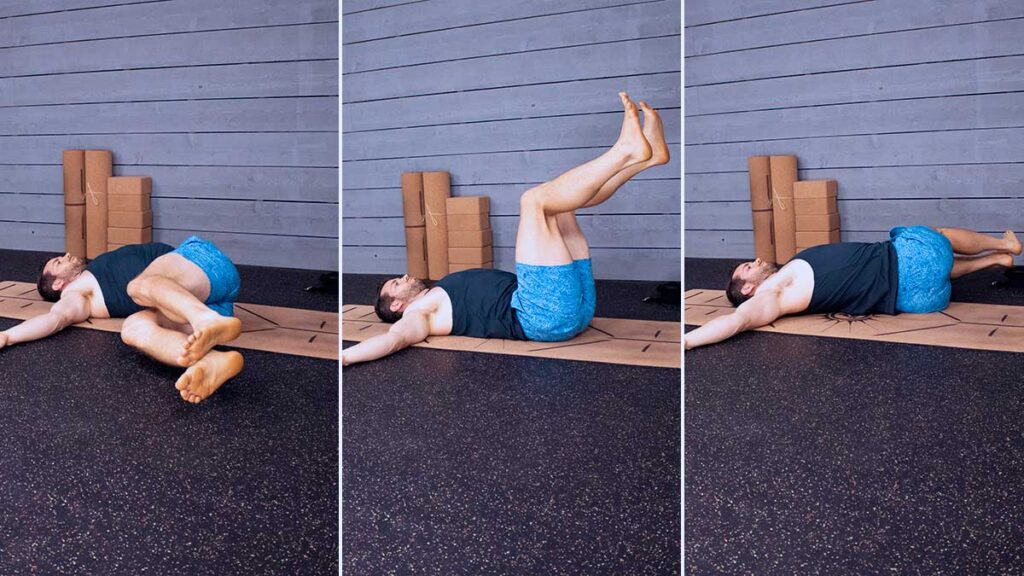 Spinal Twist
Spinal TwistFAQs
What causes bloating in men?
Bloating can be caused simply by eating too much, too fast. Or there can be more significant issues related to digestion, stress, hormones, and genetics. However, the most likely cause is poor diet, insufficient water, and not enough movement.
Is yoga good for preventing bloating?
Absolutely. If you’re enduring painful bloating, a few yoga moves like the ones mentioned below can relieve the discomfort. A regular yoga regimen can help prevent yoga episodes since yoga prevents the rapid weight gain that goes right to the belly, encourages you to drink more water, and keeps your bowels moving.
How do I prevent bloating?
Start by eating more fiber. Fiber cleans out fermenting fecal matter in your system, encourages you to drink more water, and serves as a prebiotic that promotes “good” bacteria in your gut. Avoid processed foods, which are low in fiber and promote water retention. Next, get moving. In our sedentary society, we spend much of our time sitting behind desks, hunched over steering wheels and cramped into airline seats. That discourages the movement of food throughout our bodies. By engaging in an active lifestyle, you’ll deter bloating.
What should I eat when constipated and bloated?
Chances are you won’t feel like consuming much of anything. The key, however, is to drink plenty of water and high-fiber foods such as fruits, vegetables, and whole grains. This will help move along whatever is clogging your system

 KickT
KickT 








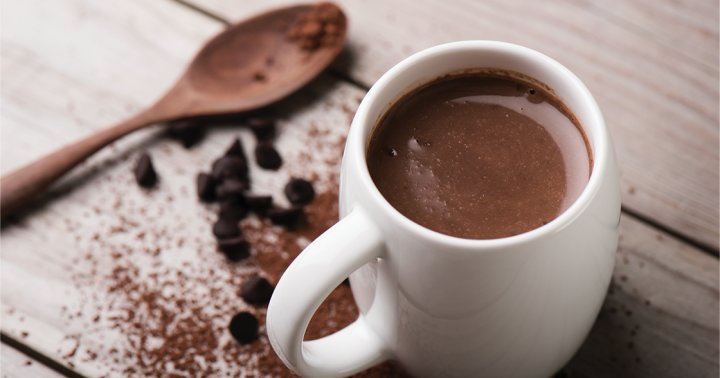

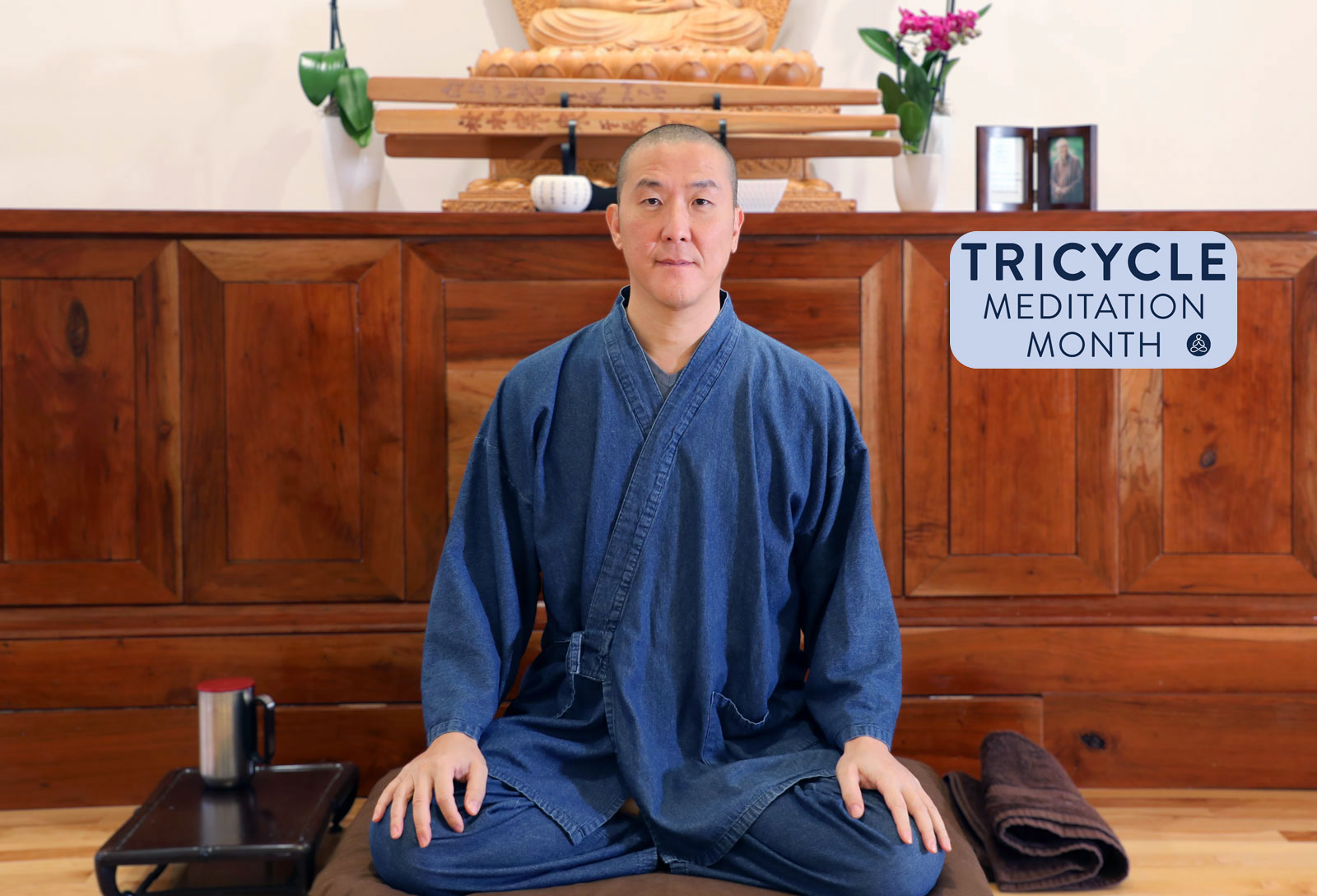











![Is ChatGPT Catching Google on Search Activity? [Infographic]](https://imgproxy.divecdn.com/RMnjJQs1A7VQFmqv9plBlcUp_5Xhm4P_hzsniPsfHiU/g:ce/rs:fit:770:435/Z3M6Ly9kaXZlc2l0ZS1zdG9yYWdlL2RpdmVpbWFnZS9kYWlseV9zZWFyY2hlc19pbmZvZ3JhcGhpYzIucG5n.webp)








